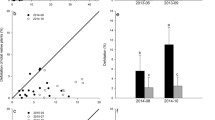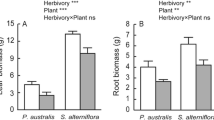Abstract
Background and Aims
The deposition of atmospheric nitrogen has increased globally and interfered with plant growth and development. However, only a few studies have examined the influence of atmospheric nitrogen deposition on plant–herbivore interactions in the framework of plant invasion, and the underlying mechanisms remain unclear.
Methods
In this study, we examined the changes in growth and herbivore resistance of the invasive weed Alternanthera philoxeroides and its native co-occurring congener Alternanthera sessilis in response to simulated nitrogen deposition. We further investigated the competitive ability of these two plant species grown in mono- and mix-culture conditions with or without herbivore pressures.
Results
The results indicated that simulated nitrogen deposition largely increased the growth of both plant species, while A. philoxeroides produced more biomass than A. sessilis. The specialist and generalist herbivores showed contrasting preferences for the two plant species in the controls, whereas A. philoxeroides showed greater resistance to both herbivore species under simulated nitrogen deposition. Further investigation of host plant traits related to leaf structural and chemical defences suggested that such difference in herbivore resistance between the two plant species could be attributed to the increased levels of structural defense in A. philoxeroides and reduced levels of defensive metabolites in A. sessilis. The inter-specific competition test revealed that simulated nitrogen deposition largely increased the competitive advantage of A. philoxeroides over A. sessilis, regardless of the presence or absence of herbivores.
Conclusion
Our study suggests that the invasiveness of A. philoxeroides may be enhanced by increased atmospheric nitrogen deposition.






Similar content being viewed by others
Data availability
The data that support the findings of this study are openly available in Dryad at https://datadryad.org/stash/share/EcctktVqEYY11f9089JBTk8g3zt7Tm_SidsFRtvremw.
References
Ackerman D, Millet DB, Chen X (2019) Global estimates of inorganic nitrogen deposition across four decades. Global Biogeochem Cycles 33:100–107
BassiriRad H (2015) Consequences of atmospheric nitrogen deposition in terrestrial ecosystems: old questions, new perspectives. Oecologia 177:1–3
Blossey B, Nötzold R (1995) Evolution of increased competitive ability in invasive nonindigenous plants: a hypothesis. J Ecol 83:887–889
Campbell SA, Vallano DM (2018) Plant defences mediate interactions between herbivory and the direct foliar uptake of atmospheric reactive nitrogen. Nat Commun 9:4743
Chen L, Mi J, Hao L, He F, Yang H, Wan X, Zhang F, Liu Y, Lin T (2022) Effects of simulated nitrogen deposition on the ecophysiological responses of Populus beijingensis and P. cathayana under intra- and interspecific competition. Plant Soil 481:127–146
Chen Y, Ni X (2011) Nitrogen modulation on plant direct and indirect defenses. In: Liu T, Kang L (eds) Recent Advances in Entomological Research. Springer, Berlin
Chen Y, Zhou Y, Yin TF, Liu CX, Luo FL (2013) The invasive wetland plant Alternanthera philoxeroides shows a higher tolerance to waterlogging than its native Congener Alternanthera sessilis. PLoS ONE 8:e81456
Dietrich R, Plob K, Heil M (2004) Constitutive and induced resistance to pathogens in Arabidopsis thaliana depends on nitrogen supply. Plant Cell Environ 27:896–906
Feng YL, Fu GL (2008) Nitrogen allocation, partitioning and use efficiency in three invasive plant species in comparison with their native congeners. Biol Invasions 10:891–902
Galloway JN, Dentener FJ, Capone DG, Boyer EW, Howarth RW, Seitzinger SP, Asner GP, Cleveland CC, Green PA, Holland EA, Karl DM, Michaels AF, Porter JH, Townsend AR, Vöosmarty CJ (2004) Nitrogen cycles: past, present, and future. Biogeochemistry 70:153–226
Gaudinier A, Rodriguez-Medina J, Zhang L, Olson A, Liseron-Monfils C, Bågman A-M, Foret J, Abbitt S, Tang M, Li B, Runcie DE, Kliebenstein DJ, Shen B, Frank MJ, Ware D, Brady SM (2018) Transcriptional regulation of nitrogen-associated metabolism and growth. Nature 563:259–264
Graça MAS, Zimmer M (2020) Physical litter properties: leaf toughness and tensile strength. In: Bärlocher F, Gessner MO, Graça MAS (eds) Methods to Study Litter Decomposition: A Practical Guide. Springer International Publishing, Cham
Guo X, Hu Y, Ma J-Y, Wang H, Wang K-L, Wang T, Jiang S-Y, Jiao J-B, Sun Y-K, Jiang X-L, Li M-Y (2023) Nitrogen deposition effects on invasive and native plant competition: implications for future invasions. Ecotoxicol Environ Saf 259:115029
Haber AI, Rivera Sustache J, Carr DE (2018) A generalist and a specialist herbivore are differentially affected by inbreeding and trichomes in Mimulus guttatus. Ecosphere 9:e02130
Hu X-T, Dong B-C (2019) Herbivory and nitrogen availability affect performance of an invader Alternanthera philoxeroides and its native congener A. sessilis. Flora 257:151412
Huangfu C, Li H, Chen X, Liu H, Wang H, Yang D (2016) Response of an invasive plant, Flaveria bidentis, to nitrogen addition: a test of form-preference uptake. Biol Invasions 18:3365–3380
Joshi J, Vrieling K (2005) The enemy release and EICA hypothesis revisited: incorporating the fundamental difference between specialist and generalist herbivores. Ecol Lett 8:704–714
Kant MR, Jonckheere W, Knegt B, Lemos F, Liu J, Schimmel BCJ, Villarroel CA, Ataide LMS, Dermauw W, Glas JJ, Egas M, Janssen A, Van Leeuwen T, Schuurink RC, Sabelis MW, Alba JM (2015) Mechanisms and ecological consequences of plant defence induction and suppression in herbivore communities. Ann Bot 115:1015–1051
Keane RM, Crawley MJ (2002) Exotic plant invasions and the enemy release hypothesis. Trends Ecol Evol 17:164–170
Lankau RA (2007) Specialist and generalist herbivores exert opposing selection on a chemical defense. New Phytol 175:176–184
Lawlor DW, Lemaire G, Gastal F (2001) Nitrogen, plant growth and crop yield. In: Lea PJ, Morot-Gaudry J-F (eds) Plant Nitrogen. Springer, Berlin Heidelberg, Berlin, Heidelberg
Li H-L, Ning L, Alpert P, Li J-M, Yu F-H (2014) Responses to simulated nitrogen deposition in invasive and native or non-invasive clonal plants in China. Plant Ecol 215:1483–1492
Li N, Yu J, Yang J, Wang S, Yu L, Xu F, Yang C (2023) Metabolomic analysis reveals key metabolites alleviating green spots under exogenous sucrose spraying in air-curing cigar tobacco leaves. Sci Rep 13:1311
Lin T, Doorduin L, Temme A, Pons TL, Lamers GE, Anten NP, Vrieling K (2015a) Enemies lost: parallel evolution in structural defense and tolerance to herbivory of invasive Jacobaea vulgaris. Biol Invasions 17:2339–2355
Lin T, Klinkhamer PGL, Pons TL, Mulder PPJ, Vrieling K (2019) Evolution of increased photosynthetic capacity and its underlying traits in invasive Jacobaea vulgaris. Front Plant Sci 10:1016
Lin T, Klinkhamer PGL, Vrieling K (2015b) Parallel evolution in an invasive plant: effect of herbivores on competitive ability and regrowth of Jacobaea vulgaris. Ecol Lett 18:668–676
Liu Y, Oduor AMO, Zhang Z, Manea A, Tooth IM, Leishman MR, Xu X, van Kleunen M (2017) Do invasive alien plants benefit more from global environmental change than native plants? Glob Change Biol 23:3363–3370
Lu X, Siemann E, Wei H, Shao X, Ding J (2015) Effects of warming and nitrogen on above- and below-ground herbivory of an exotic invasive plant and its native congener. Biol Invasions 17:2881–2892
Lucas PW, Turner IM, Dominy NJ, Yamashita N (2000) Mechanical defences to herbivory. Ann Bot 86:913–920
Mithöfer A, Boland W (2012) Plant defense against herbivores: chemical aspects. Annu Rev Plant Biol 63:431–450
Pan X, Geng Y, Alejandro S, Zhang W, Li B, Chen J (2007) Invasive Alternanthera philoxeroides: biology, ecology and management. J Syst Evol 45:884–900
Poorter H, Niinemets Ü, Poorter L, Wright IJ, Villar R (2009) Causes and consequences of variation in leaf mass per area (LMA): a meta-analysis. New Phytol 182:565–588
Reay DS, Dentener F, Smith P, Grace J, Feely RA (2008) Global nitrogen deposition and carbon sinks. Nat Geosci 1:430–437
Rickey M, Anderson R (2004) Effects of nitrogen addition on the invasive grass Phragmites australis and a native competitor Spartina pectinata. J Appl Ecol 41:888–896
Sanané I, Legrand J, Dillmann C, Marion-Poll F (2021) High-Throughput Feeding Bioassay for Lepidoptera Larvae. J Chem Ecol 47:642–652
Sharma A, Kaur A, Kaur S, Kohli RK, Batish DR (2023) Plant Invasion and Climate Change: a global overview. In: Tripathi S, Bhadouria R, Srivastava P, Singh R, Batish DR (eds) Plant Invasions and Global Climate Change. Springer Nature Singapore, Singapore
Song L, Liu X, Skiba U, Zhu B, Zhang X, Liu M, Twigg M, Shen J, Dore A, Reis S, Coyle M, Zhang W, Levy P, Fowler D (2018) Ambient concentrations and deposition rates of selected reactive nitrogen species and their contribution to PM2.5 aerosols at three locations with contrasting land use in southwest China. Environ Pollut 233:1164–1176
Strauss SY, Rudgers JA, Lau JA, Irwin RE (2002) Direct and ecological costs of resistance to herbivory. Trends Ecol Evol 17:278–285
Su Z, Xiao Q, Shen J, Chen H, Yan S, Huang W (2021) Metabolomics analysis of litchi leaves during floral induction reveals metabolic improvement by stem girdling. Molecules 26:4048
Sun Y, Ding J, Frye MJ (2010) Effects of resource availability on tolerance of herbivory in the invasive Alternanthera philoxeroides and the native Alternanthera sessilis. Weed Res 50:527–536
Tanaka S, Zhu D-H (2005) Outbreaks of the migratory locust Locusta migratoria (Orthoptera: acrididae) and control in China. Appl Entomol Zool 40:257–263
Throop HL, Lerdau MT (2004) Effects of nitrogen deposition on insect herbivory: implications for community and ecosystem processes. Ecosystems 7:109–133
Vallano DM, Selmants PC, Zavaleta ES (2012) Simulated nitrogen deposition enhances the performance of an exotic grass relative to native serpentine grassland competitors. Plant Ecol 213:1015–1026
Vilà M, Corbin JD, Dukes JS, Pino J, Smith SD (2007) Linking Plant Invasions to Global Environmental Change. In: Canadell JG, Pataki DE, Pitelka LF (eds) Terrestrial Ecosystems in a Changing World. Springer, Berlin Heidelberg, Berlin, Heidelberg
Wang Y, Chen C, Xiong YT, Wang Y, Li QJ (2021) Combination effects of heavy metal and inter-specific competition on the invasiveness of Alternanthera philoxeroides. Environ Exp Bot 189:104532
Yan H, Feng L, Zhao Y, Feng L, Wu D, Zhu C (2020) Prediction of the spatial distribution of Alternanthera philoxeroides in China based on ArcGIS and MaxEnt. Global Ecology and Conservation 21:e00856
Zettlemoyer MA (2022) Leaf traits mediate herbivory across a nitrogen gradient differently in extirpated vs. extant prairie species. Oecologia 198:711–720
Zhao L, Jia D, Yuan X, Guo Y, Zhou W, Ma R (2015) Cold hardiness of the biological control agent, Agasicles hygrophila, and implications for its potential distribution. Biol Control 87:1–5
Acknowledgements
This study was financially supported by the National Key Research and Development Program of China (Grant No.: 2022YFC2601100), Natural Science Foundation of China (Grant No.: 32001204), the Department of Science and Technology of Yunnan Province (Grant No.: 202405AS350011), and the Yunnan Fundamental Research Projects (Grant No.: 202401AT070437).
Author information
Authors and Affiliations
Contributions
TL and BL planned and designed the research; ZW and MK performed experiments and analyzed data; GZ and AM contributed to material collection and method development; TL, ZW, KV and BL wrote the manuscript. All authors contributed to the corrections of the manuscript.
Corresponding author
Ethics declarations
Conflict of Interest
The authors declare that they have no known competing financial interests or personal relationships that could have appeared to influence the work reported in this paper.
Additional information
Responsible Editor: Luca Bragazza.
Publisher's Note
Springer Nature remains neutral with regard to jurisdictional claims in published maps and institutional affiliations.
Supplementary Information
Below is the link to the electronic supplementary material.
Rights and permissions
Springer Nature or its licensor (e.g. a society or other partner) holds exclusive rights to this article under a publishing agreement with the author(s) or other rightsholder(s); author self-archiving of the accepted manuscript version of this article is solely governed by the terms of such publishing agreement and applicable law.
About this article
Cite this article
Lin, T., Wang, Z., Ke, M. et al. Simulated nitrogen deposition increased herbivore resistance and competitive ability of an invasive plant species over a native co-occurring congeneric species. Plant Soil (2024). https://doi.org/10.1007/s11104-024-06707-6
Received:
Accepted:
Published:
DOI: https://doi.org/10.1007/s11104-024-06707-6




